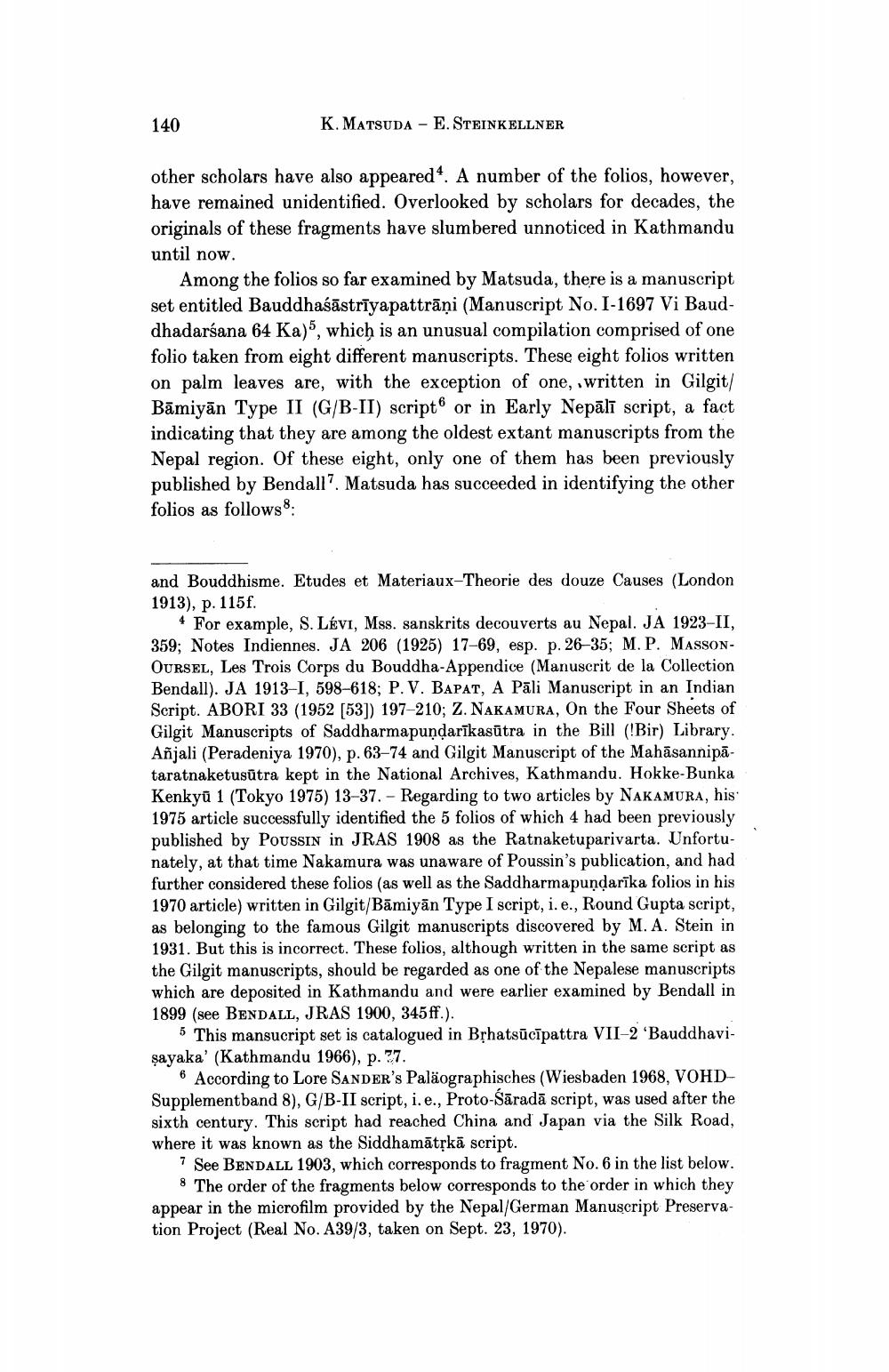Book Title: Sanskrit Manuscript Of Dharmakirtis Pramanaviniscaya Author(s): Kazunobu Matsuda, Ernat Steinkellner Publisher: Kazunobu Matsuda, Ernat Steinkellner View full book textPage 2
________________ 140 K. MATSUDA - E. STEINKELLNER other scholars have also appeared. A number of the folios, however, have remained unidentified. Overlooked by scholars for decades, the originals of these fragments have slumbered unnoticed in Kathmandu until now. Among the folios so far examined by Matsuda, there is a manuscript set entitled Bauddhaśāstrīyapattrāņi (Manuscript No. I-1697 Vi Bauddhadarśana 64 Ka)5, which is an unusual compilation comprised of one folio taken from eight different manuscripts. These eight folios written on palm leaves are, with the exception of one, written in Gilgit/ Bāmiyān Type II (G/B-II) script or in Early Nepālī script, a fact indicating that they are among the oldest extant manuscripts from the Nepal region. Of these eight, only one of them has been previously published by Bendall? Matsuda has succeeded in identifying the other folios as follows: and Bouddhisme. Etudes et Materiaux-Theorie des douze Causes (London 1913), p. 115f. * For example, S. LÉVI, Mss. sanskrits decouverts au Nepal. JA 1923-II, 359; Notes Indiennes. JA 206 (1925) 17–69, esp. p. 26-35; M. P. MASSONOURSEL, Les Trois Corps du Bouddha-Appendice (Manuscrit de la Collection Bendall). JA 1913-I, 598-618; P.V. BAPAT, A Pāli Manuscript in an Indian Script. ABORI 33 (1952 [53]) 197-210; Z. NAKAMURA, On the Four Sheets of Gilgit Manuscripts of Saddharmapundarīkasūtra in the Bill (Bir) Library. Añjali (Peradeniya 1970), p. 63-74 and Gilgit Manuscript of the Mahāsannipātaratnaketusūtra kept in the National Archives, Kathmandu. Hokke-Bunka Kenkyū 1 (Tokyo 1975) 13-37. - Regarding to two articles by NAKAMURA, his 1975 article successfully identified the 5 folios of which 4 had been previously published by POUSSIN in JRAS 1908 as the Ratnaketuparivarta. Unfortunately, at that time Nakamura was unaware of Poussin's publication, and had further considered these folios (as well as the Saddharmapundarīka folios in his 1970 article) written in Gilgit/Bāmiyān Type I script, i.e., Round Gupta script, as belonging to the famous Gilgit manuscripts discovered by M. A. Stein in 1931. But this is incorrect. These folios, although written in the same script as the Gilgit manuscripts, should be regarded as one of the Nepalese manuscripts which are deposited in Kathmandu and were earlier examined by Bendall in 1899 (see BENDALL, JRAS 1900, 345ff.). 5 This mansucript set is catalogued in Brhatsūcīpattra VII-2 'Bauddhavişayaka' (Kathmandu 1966), p. 27. 6 According to Lore SANDER's Paläographisches (Wiesbaden 1968, VOHDSupplementband 8), G/B-II script, i.e., Proto-Sāradā script, was used after the sixth century. This script had reached China and Japan via the Silk Road, where it was known as the Siddhamātņkā script. 7 See BENDALL 1903, which corresponds to fragment No. 6 in the list below. 8 The order of the fragments below corresponds to the order in which they appear in the microfilm provided by the Nepal/German Manuscript Preservation Project (Real No. A39/3, taken on Sept. 23, 1970).Page Navigation
1 2 3 4 5 6 7 8 9 10 11 12
